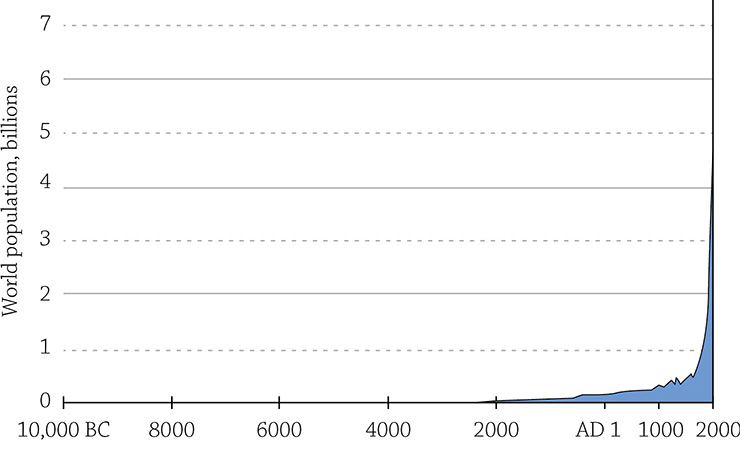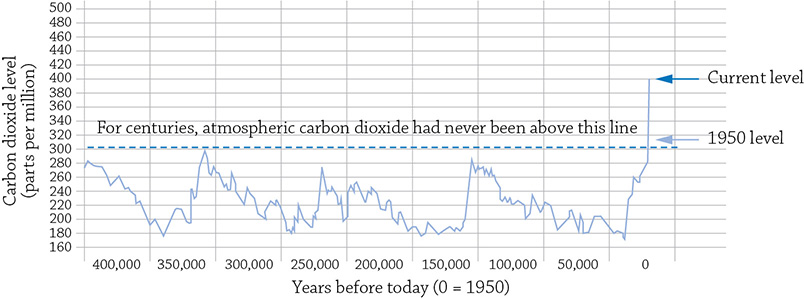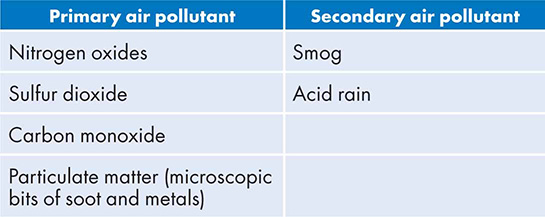Must Know High School Biology - Kellie Ploeger Cox 2019
PART SIX Ecology
Human Impact on Ecosystems
MUST ![]() KNOW
KNOW
![]() Humans depend on ecosystems for resources, and our needs sometimes cause damage.
Humans depend on ecosystems for resources, and our needs sometimes cause damage.
Ahealthy ecosystem is a complex web of many different populations. In general, the higher the biodiversity (different number of species), the more stable the ecosystem. Yet no matter how stable an ecosystem may be, it is still subject to change. Anything that disrupts the communities in an ecosystem is referred to as a disturbance. Disturbances to ecosystems can be natural or human-caused. Our must know for this chapter will focus on the human-induced stress: we need resources, and sometimes ecosystems suffer for it.
Natural Disturbances and Ecological Succession
Even without us humans around, ecological disturbances occur. Natural disasters can wipe out entire communities, such as when a tsunami or hurricane hits the coast. A tornado has the same devastating effect, but its swath of destruction is only along the path it travels across the landscape. Volcanoes, lightning-sparked forest fires, and floods are all examples of natural disasters. Once the disturbance is over, the ecosystem will work on repairing itself by reestablishing the populations that once inhabited the area; this is called ecological succession. There are two types of ecological succession, depending on the severity of the damage: primary succession or secondary succession.
Primary succession is starting from scratch … there is literally nothing but rock and not the slightest spark of life is present. The types of natural disturbance capable of creating these harsh conditions include volcanic eruptions (lava!) and landslides. The first forms of life to colonize the previously uninhabited area are called pioneer species, and are usually moss and lichen blown in by the wind or brought in by migrating animals. These unassuming life-forms are able to live on the rocks and slowly help their disintegration into smaller particles, contributing to the formation of new soil.
![]()
IRL
Moss is a primitive type of plant, but lichen is not a plant. Lichen is also not a fungus … nor a bacterium … nor a protist. Strangely enough, lichen isn’t actually a single type of life: lichen is a permanent mutualistic pairing of a photosynthetic bacterium (cyanobacteria) or protist, plus its buddy, a fungal filament that offers protection and housing. We learned about this symbiotic relationship in a previous chapter!
As the rock disintegrates and microorganisms begin to colonize newly formed niches, soil forms. Happily, grasses can now grow. After a few decades, a young forest will emerge, and eventually, transition to an older forest with larger trees. A climax community is achieved once the ecosystem is back in a healthy equilibrium after years of succession.
Secondary succession is an easier ecological “healing” process. In this case, a natural disruption such as a fire or flood leaves the soil intact. The process of recolonization of plants is much quicker, because a healthy soil is already available. Primary succession takes a long, long time because the process of forming soil from rock is the most time-consuming step; secondary succession regrowth is much quicker.
For example, consider a building construction site that has been cleared of its vegetation. In no time at all, new plants around the area begin to grow and fill in the patches of empty soil—a perfect example of secondary succession. The process of regrowth continues until a climax community forms.
Human-Caused Disturbances
Our must know focuses on the stress the human population exerts on natural ecosystems. Consider the startling exponential growth curve of human population growth.

World population increase
Author: El T. https://commons.wikimedia.org/wiki/File:Population_curve.svg
There have been amazing advances that allowed the human population to increase exponentially, such as industrialized farming, better sanitation, and advances in medicine. But recall from an earlier chapter the significance of a population undergoing exponential growth. It is almost impossible to maintain such growth, because it required unlimited resources and space … certainly not sustainable when you consider Earth as a whole.
This, unfortunately, puts a strain on the planet’s natural resources. Some resources are renewable, meaning they can be replaced at the same rate by which they are consumed. Renewable resources include solar energy, wind energy, hydroelectric, and geothermal. Others are nonrenewable because they are used faster than they are able to form. Fossil fuels (such as coal, natural gas, and petroleum) are nonrenewable resources.
![]()
IRL
Unfortunately, the means by which we acquire these nonrenewable resources are often damaging to ecosystems: hydraulic fracturing (fracking), drilling, and mining.
CO2 Emissions and Climate Change
Ecosystems innately strive for homeostasis and balance. Because matter on Earth remains in a closed system, an ecosystem will reach a happy equilibrium as an element (such as carbon) is cycled throughout the atmosphere and fixed back into organic matter as the biotic members of the ecosystem live, breathe, and eat. Sadly, the carbon cycle can be thrown out of whack by an “outside” introduction of atmospheric carbon dioxide. If this imbalance becomes too big, it can lead to climate change. Climate change refers to a global phenomenon brought about by burning fossils fuels and increasing the amounts of carbon dioxide in the atmosphere.
Carbon dioxide is considered a greenhouse gas because it increases the amount of heat trapped in the atmosphere. Solar (sun) radiation enters the atmosphere, heats Earth’s surface, and the energy is “bounced back” as infrared (IR) radiation. This IR radiation is absorbed by atmospheric gases and ends up warming the air … the greenhouse effect in action. Human-generated greenhouse gases attribute greatly to this effect. Other greenhouse gases include methane, nitrous oxide, and chlorofluorocarbons (CFs).
By studying carbon dioxide levels locked in ice samples from hundreds of thousands of years ago (and more recent readings collected directly from the atmosphere), data can be studied to show a statistically significant increase in atmospheric carbon dioxide, beyond that of natural geological cycling.
![]()
Do not make the mistake of thinking the greenhouse effect is a bad thing. There would not be life on Earth if it wasn’t for the (natural) greenhouse effect. Without it, the atmosphere would not be warm enough to sustain life!

Atmospheric CO2 levels during the last 400,000 years
Author: Vostok ice core data/J.R. Petit et al. https://climate.nasa.gov/evidence.
Pollution
Pollution is defined as adding something to the environment that has a negative impact on the environment. Pollution can be as obvious as trash floating along the edges of a stream, or more insidious such as acid rain. We will discuss two general types of pollution, based on whether it originates in the air or in the water.
Air Pollution
Most of our air pollution comes from transportation emissions. There are a lot of automobiles out there, and most of them rely on fossil fuels. Furthermore, power plants, refineries, and industrial plants also rely on fossil fuels and add to the atmospheric pollution. Air pollutants can be categorized as primary pollutants and secondary pollutants. Any nasty chemical released directly into the atmosphere is a primary pollutant. If that chemical reacts with the atmosphere to create a new (and also nasty) second chemical, that is referred to as a secondary pollutant. On the following page is a table summarizing some of these pollutants.

Smog, a secondary air pollutant, is a hazy, low-hanging layer that obscures the view of the horizon. It is composed of particulate matter and something called ground-level ozone. Ozone (O3) is normally found in a layer in Earth’s upper atmosphere, where it plays an important role of absorbing dangerous UV radiation that would otherwise damage cells. Ground-level ozone is not natural, and it is not beneficial. The nitrogen oxides released from burning fossil fuels react with atmospheric oxygen and sunlight to form ground-level ozone. Breathing even relatively low levels of ozone can reduce lung function and cause a variety of health problems.
Acid rain is another secondary pollutant, formed when water molecules react with atmospheric gases.

Rainwater is normally slightly acidic (neutral pH is 7; anything lower than 7 is considered acidic), and naturally occurring carbonic acid alone can acidify rain to a pH of 5.6. Add to that mix human-generated sulfuric and nitric acid, and the pH can reach levels as low as 3! Acid rain can have devastating effects on aquatic environments, and the animal and plant inhabitants of such acidified ecosystems suffer greatly.
Water Pollution
Water pollution can mean the obvious trash contamination of water, or a more subtle chemical imbalance that causes unhealthy events, such as algal blooms. An algal bloom is just what it sounds like—a sudden increase in the amount of algae growing in either a freshwater or saltwater ecosystem. In truth, the term algal bloom can also refer to an overgrowth in cyanobacteria (these photosynthetic prokaryotes are often mistaken for algae, which is a protist). Either way, the hallmark sign of an algal bloom is unusually green water (though an algal bloom can also color the water red or brown). Why is this bad, you ask? Green means lots of happy photosynthetic life, and how could that be bad? If the process of photosynthesis releases oxygen as a by-product, why would that hurt an aquatic ecosystem? But I’m getting ahead of myself. Let me explain why this overgrowth happens in the first place.
A limiting factor refers to a nutrient needed for something to grow, and its scarcity limits the growth of the organism. Phosphorus is a limiting factor in the soil for plant growth, which is why it is a major component of fertilizer. Sometimes excess fertilizer leaches from the soil into water runoff, ending up in nearby lakes, ponds, and other bodies of water. Phosphorous also acts as a limiting factor in the water, keeping algal growth in check. Once runoff enters the aquatic ecosystem, the algae happily begin to grow like crazy (which is why the water turns green!).
The problem occurs when the algae begins to die (they are short-lived little critters). Any dead organic matter will begin to decay and be consumed by decomposers. These busy decomposers are undergoing cellular respiration and consuming the dissolved oxygen at an alarming rate, causing hypoxic (low oxygen) conditions. Because the oxygen levels are dropping, aquatic animals and plants start to die off.
Unfortunately, fertilizer runoff is not the only source of phosphorous water pollution. Many household cleaning solutions contain phosphorous, and their overuse can also lead to algal bloomsa.
REVIEW QUESTIONS
1. Compare and contrast the two types of ecological succession.
2. A _______________ resource can be replaced at the same rate by which it is consumed. Give an example of this type of resource: _______________.
3. How are primary and secondary pollutants related?
4. Using the following terms, explain how phosphorus can damage an aquatic ecosystem: algal bloom, decomposers, fertilizer, hypoxic, limiting factor, phosphorus.
5. For each of the following examples, indicate whether it is primary succession (PS) or secondary succession (SS):
a. Chernobyl nuclear contamination
b. California wildfires
c. Mount St. Helens volcanic eruption
d. Deforestation of Amazon rainforest
e. Retreating glaciers in Alaska
6. What important role does lichen play in primary succession?
7. How does the burning of fossil fuels contribute to the phenomenon of climate change?
